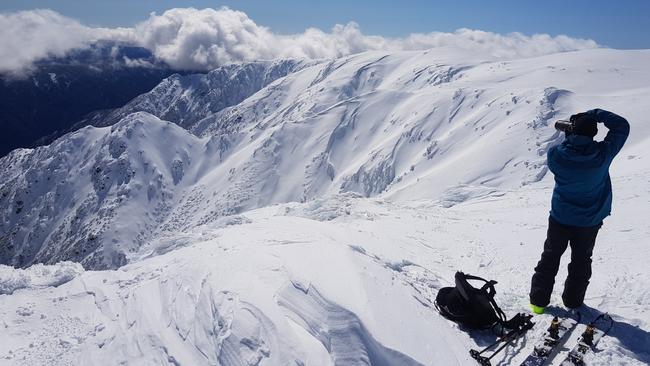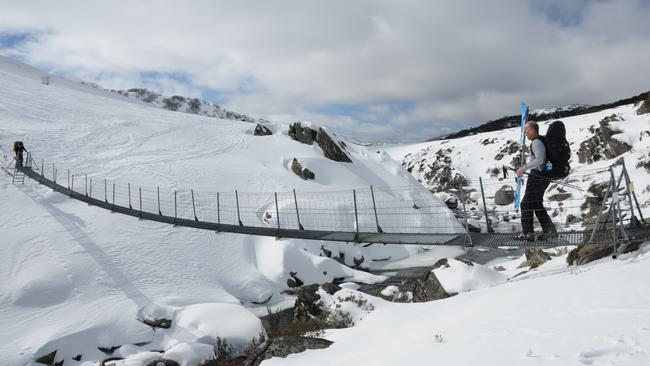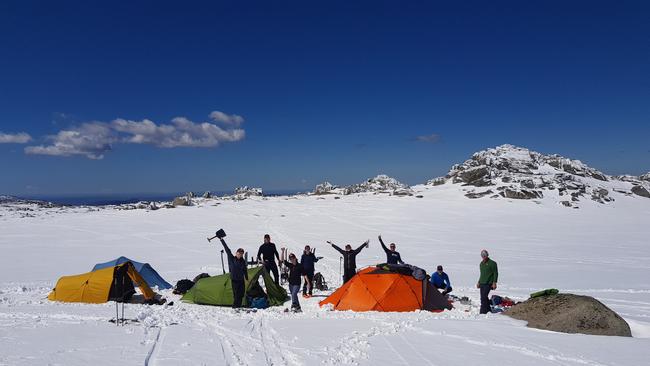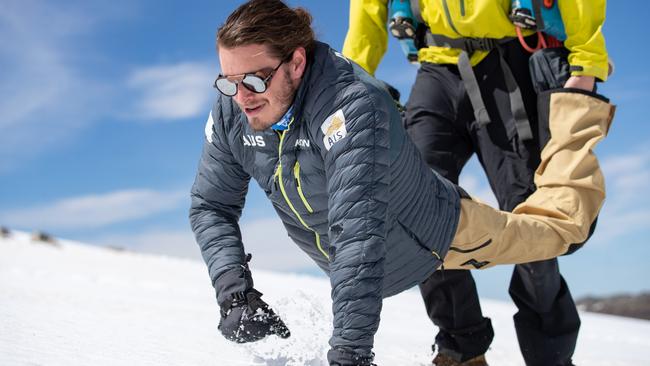Snowy serenade to a pandemic-hit ski season
In an unusual ski season, Huw Kingston experiences blissful backcountry runs — and a snowy serenade by Richard Tognetti.
His crimson jacket stood out against the white of the snow beneath his skis and the billowing mass of cumulus covering Victoria far below. A cover that only seemed to add to its out-of-bounds status in the winter of 2020. I made half a dozen lazy turns towards him from the summit slopes of Mount Twynam, Australia’s third-highest peak. “That you, Huw?” said a voice, muffled in equal measure by a biting wind and a buff covering the lower half of his face. The last time I’d literally bumped into Tim was biking down a sweltering hot, dusty track in the remote Kimberley nearly 20 years before.
Tim Macartney-Snape was, in 1984, the first Australian to climb Mount Everest. He repeated the feat six years later, this time climbing from sea level to the summit. Before those heights though it was the backcountry of Kosciuszko National Park that captured Tim’s attention. His passion for this place, on skis in winter, is undiminished.
His earliest trips were with John Mitchell, youngest son of Tom and Elyne Mitchell, who pioneered backcountry skiing in the 1930s, leaving Towong Hill, their cattle station near Corryong, just over the border in Victoria, to head into the highest country. As well as skiing, Elyne wrote the Silver Brumby series of children’s books and Tom was a long-serving MP in the Victorian government. I briefly met John in the pub at Khancoban early in the 2020 winter, just months after his homestead at Towong Hill was reduced to rubble in our blazing summer.
“Let’s do a run then,” I suggested to Tim and soon the two of us were diving into that cloud sea, skiing down a steep, snow-choked gully on the rugged Western Faces. The ridges, faces, gullies and creeks that drop off the top of the Snowy Mountains offer, without doubt, the most challenging and extensive ski runs in Australia. But here there is no chairlift to bring you back up. The further down you go, the further up you must climb, on foot or on skis with skins attached – strips of carpet-like fabric that glue to the base of your skis.
Tim and I eventually stopped at Watson’s Creek. Stopped skiing, still grinning. A small hole in the snow revealed the creek bubbling beneath and we drank our fill before the long, hot climb out. Despite him having almost a decade on me, Tim ran me ragged that August day. We did another run, and another, then another, in some of the best snow conditions of the winter.

The Snowies, like so much of the country, had seen tourism, its economic lifeblood, eroded by our blackest of summers. The fires themselves spared the highest mountains and the communities around them but it had been close. The northern end of the national park, though, had been devastated, including the ski resort of Mount Selwyn. Twisted, blackened ski lift towers amid twisted, blackened tree trunks.
Then came autumn, came Covid. “NSW Health actually wanted us to have some sort of ski season,” Stuart Diver, Thredbo’s general manager, tells me. “After the first wave of coronavirus had settled, they recognised the economic necessity and mental health needs for our local community in operating.” Finally, from late May, the resorts began to announce their plans: a later than usual start to the season, reduced capacity, online pre-purchased tickets only, no season tickets for some resorts, no snowplay.
Still we rejoiced, felt optimistic. Skiers the world over are optimists. Even more so in a country not known for endless metres of the white stuff. When tickets did go on sale, online portals melted down. Diver again: “We knew it would be busy and scaled up. But 38,000 in one day!” People refreshed their screens for up to 12 hours to secure tickets. Many were disappointed.
Mother nature too was up to her unpredictable old tricks and failed to deliver the goods. The ground lay bare over most of the resorts through June and it wasn’t until part way through July that we could celebrate. Those of us in NSW, at least. In Victoria, if you were going to have the sparsest snowfall for decades, perhaps 2020 was the year to have it. It mattered little as, only days after they opened, Victoria moved into lockdown. The resorts closed, a rotten blow for north-east Victoria.
“Pull your face mask up please mate,” smiled Donna, lift operator on the Sun Valley T-bar at Perisher. She and her “liftie” colleagues at Perisher – the biggest ski resort in the southern hemisphere and the first in the world to mandate the wearing of masks – could never in their wildest dreams have imagined their winter would be spent monitoring mask-wearing by day and not partying by night.

Australia’s highest land on the world’s flattest continent is a very special place. A wombat might shuffle nonchalantly across the snow and, while he does, a pair of crimson rosellas flash across the marbled, ice-rimed trunk of a snowgum. I learnt to ski here 35 years ago, a bumming-around British backpacker working the season at the tiny, snowbound NSW resort of Charlotte Pass.
The view of the Main Range from the top of Kangaroo Ridge chairlift soon tempted me beyond the resort boundary. Temptation that, with enthusiasm but perhaps not enough skill, saw me disoriented and benighted in a blizzard. With a young lady from Perth, who had first seen snow only the week before, we huddled through a long, wild night. A frigid but thankfully clear dawn found us only metres away from Seamans Hut, a shelter commemorating two less fortunate skiers who had perished nearby in 1928.
Ten years later, imbued with rather more experience, I skied the length of the Australian Alps, from the most southerly snows in Victoria to those at the northern end of Kosciuszko National Park. It was a tough but magical journey. I didn’t see another soul in the first three weeks and, when I finally popped out at Mount Hotham ski resort, I learnt of the death of Princess Diana. Ten days later I arrived at Thredbo where, that same winter, 18 people had been killed, including a close friend, Diane, in a terrible landslide. Stuart Diver was, of course, the only survivor from that tragedy.
There was much talk early in the winter of 2020 that the backcountry, the vast areas beyond the resorts, would be a busier place. Up above the treeline, the mountains were indeed criss-crossed by tracks from skiers and snowboarders along with the yeti-like prints of snowshoers. “We sold more snowshoes and ran more tours than I can ever remember,” says Acacia Rose of K7 Adventures. “People were definitely looking for something different to do.”
It was late on a Sunday afternoon, mid-September, misty and drizzling, in a deserted resort car park when I strapped a carbon violin case to my already bulging pack. Winter had played its own tune all season with snowstorms few and far between. In truth the winter of 2020, like the year of 2020, was less than average. A ridiculously warm September had played havoc with the snow cover. With temperatures rarely falling below freezing, even at night, the resorts struggled to use their snow-making guns to top up the cover.
Richard Tognetti, artistic director and principal violinist of the Australian Chamber Orchestra, was heading out with me for a few backcountry days and nights. A keen resort skier, this was his first time beyond the boundaries. He was as excited by the prospect as he was the previous week when the ACO performed live for the first time in six months. We trudged into the gloom, slipping and sliding on mud and snow patches as far as the shaky suspension bridge that crosses the only section of the Snowy River still running free. Talk of rivers and dams was fitting, with Richard in the midst of composing the score to River, a new documentary film to follow up the successful Mountain. Crossing the bridge, the violin case strap caught on a stanchion; fortunately I caught it before it dropped into the swollen river. More fortunately, I was not entrusted with Richard’s $15 million Guarneri concert piece. Once across the Snowy we put skis on and continued, almost until dark, to camp.

The bad weather blew itself out overnight and blue sky greeted beanie-clad heads emerging from tiny tents. Strong coffee brewed as a stream of enthusiastic skiers passed our camp en route to the tops. Fully caffeinated, with porridge lining our stomachs, we went first to Blue Lake, taking a steep, icy chute down to mainland Australia’s largest glacial lake. We picked our way around the edge of the thinning lake ice, true blue to its name, as it can appear in those few weeks of the spring thaw. Avalanches are uncommon in Australia but certainly occur. At Blue Lake a large slide had recently brought car-sized snow blocks cascading to the edge of the lake. An avalanche in the same place had taken the life of a young skier a decade earlier; a rare fatality and salient reminder.
Sticking skins onto our skis, we climbed onto the main ridge of the Snowies. From here waters flow west to the green of Victoria and down the Murray or east to the brown of the Monaro and down the Snowy. For decades I’ve loved that colour contrast, the Snowy Mountains rain shadow so often blocking moisture from reaching further into NSW. But, in this winter of 2020, I felt a different contrast. Each time I stood on those highest peaks I felt both lucky and guilty. To be up in one of my favourite places while, 2000m below, Victoria sat out the winter in a grim lockdown.
Over we went to the Western Faces, dropping runs on glorious, sun-softened snow. From the summit of Mount Anderson, Richard swapped ski poles for violin bow. As a serenade to skiing and the Snowies and in surely one of the finest venues he had ever played, he took off, linking turn after tune after turn. Starting with Vivaldi’s Winter and moving on to Kreisler’s Liebesleid. Violin storms indeed. If a backcountry run off a mountain summit can, on occasions, reduce me to tears of joy, imagine how it felt in that special moment?

That too-warm early spring attacking a low snowdepth had, as October approached, forced Thredbo to close early, Charlotte Pass too, leaving Perisher as the only Australian ski area still open by the long weekend. I wondered how the resorts had managed to remain upbeat, kept staff morale strong, operating through such a challenging winter. Stuart Diver, positive as ever: “Sure it was so disappointing to close early. But our guests and community appreciated how lucky we were to have a season at all in 2020. There was certainly a collective sigh of relief when, by hard work and perhaps some luck, we arrived at season’s end without a single case of coronavirus.”

My final guiding job of the season was to take four 17-year-old girls and their dads on a three-day ski and snow camp. They came to the Snowies after Covid cancelled first their Kokoda Track plans, then those for the Tasmanian Overland Track. A week out it was looking more like a walk and grass camp. Then our fickle friend dumped half a metre of fresh, light snow and the mountains were once again transformed. The trip was not without incident, with broken knee and broken ski adding to the fun. Jess Greig, granddaughter of cricketing legend Tony, suffered the knee injury, but was hardly deterred. “It was unforgettable out there,” says Jess. “Dad and I were saying how adventure trips make you truly appreciate what we take for granted every day: a comfortable bed, guaranteed warmth, hot showers, a toilet. Exposing yourself to all the elements of nature is a very grounding and rewarding experience. In some ways, the more adversity you encounter, the more rewarding the experience.”

As the spring snowline crept ever higher on the flanks of the Main Range, 29-year-old Sam Tait decided he wanted a taste of the backcountry. He wanted to reach the summit of Mount Kosciuszko under his own steam. “It has been such a crazy year and, for me, it seemed a worthy but crazy goal to have for this winter,” says Sam. Seven years ago he became a paraplegic in a motorbike accident. He took to sit-skiing, representing Australia in the 2018 PyeongChang Winter Paralympics, and hopes to do likewise in Beijing in 2022.
Setting off from Charlotte Pass in mid-October, Sam hand-cycled along the old summit road towards Seamans Hut. He human-wheelbarrowed across stretches of snow, his arms elbow-deep while volunteers held his unhelpful legs. Beyond the hut he climbed into his cross-country sit-ski and, using ski poles, propelled his way towards Rawson Pass. From the pass, a steep face guards the final summit slopes. His team went ahead to set up ropes and, for more than two hours, hand over hand, Sam hauled himself up the face. “Everything screamed pain: my biceps, my forearms, my hands. I was in cold shade but determined to see the sunset from the roof of Australia.” Seven hours after starting, the final rays of sun lit up a completely spent but extremely happy young man.

To join the conversation, please log in. Don't have an account? Register
Join the conversation, you are commenting as Logout